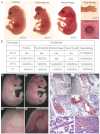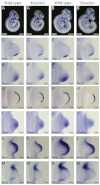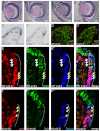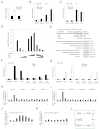Function of Wnt/β-catenin in counteracting Tcf3 repression through the Tcf3-β-catenin interaction
- PMID:22573616
- PMCID: PMC3357906
- DOI: 10.1242/dev.076067
Function of Wnt/β-catenin in counteracting Tcf3 repression through the Tcf3-β-catenin interaction
Abstract
The canonical Wnt/β-catenin signaling pathway classically functions through the activation of target genes by Tcf/Lef-β-catenin complexes. In contrast to β-catenin-dependent functions described for Tcf1, Tcf4 and Lef1, the known embryonic functions for Tcf3 in mice, frogs and fish are consistent with β-catenin-independent repressor activity. In this study, we genetically define Tcf3-β-catenin functions in mice by generating a Tcf3ΔN knock-in mutation that specifically ablates Tcf3-β-catenin. Mouse embryos homozygous for the knock-in mutation (Tcf3(ΔN/ΔN)) progress through gastrulation without apparent defects, thus genetically proving that Tcf3 function during gastrulation is independent of β-catenin interaction. Tcf3(ΔN/ΔN) mice were not viable, and several post-gastrulation defects revealed the first in vivo functions of Tcf3-β-catenin interaction affecting limb development, vascular integrity, neural tube closure and eyelid closure. Interestingly, the etiology of defects indicated an indirect role for Tcf3-β-catenin in the activation of target genes. Tcf3 directly represses transcription of Lef1, which is stimulated by Wnt/β-catenin activity. These genetic data indicate that Tcf3-β-catenin is not necessary to activate target genes directly. Instead, our findings support the existence of a regulatory circuit whereby Wnt/β-catenin counteracts Tcf3 repression of Lef1, which subsequently activates target gene expression via Lef1-β-catenin complexes. We propose that the Tcf/Lef circuit model provides a mechanism downstream of β-catenin stability for controlling the strength of Wnt signaling activity during embryonic development.
Figures







Similar articles
- Tcf3 represses Wnt-β-catenin signaling and maintains neural stem cell population during neocortical development.Kuwahara A, Sakai H, Xu Y, Itoh Y, Hirabayashi Y, Gotoh Y.Kuwahara A, et al.PLoS One. 2014 May 15;9(5):e94408. doi: 10.1371/journal.pone.0094408. eCollection 2014.PLoS One. 2014.PMID:24832538Free PMC article.
- A dynamic exchange of TCF3 and TCF4 transcription factors controls MYC expression in colorectal cancer cells.Shah M, Rennoll SA, Raup-Konsavage WM, Yochum GS.Shah M, et al.Cell Cycle. 2015;14(3):323-32. doi: 10.4161/15384101.2014.980643.Cell Cycle. 2015.PMID:25659031Free PMC article.
- Mouse Tcf3 represses canonical Wnt signaling by either competing for β-catenin binding or through occupation of DNA-binding sites.Solberg N, Machon O, Machonova O, Krauss S.Solberg N, et al.Mol Cell Biochem. 2012 Jun;365(1-2):53-63. doi: 10.1007/s11010-012-1243-9. Epub 2012 Jan 22.Mol Cell Biochem. 2012.PMID:22270545
- Wnt signalling in mouse gastrulation and anterior development: new players in the pathway and signal output.Arkell RM, Fossat N, Tam PP.Arkell RM, et al.Curr Opin Genet Dev. 2013 Aug;23(4):454-60. doi: 10.1016/j.gde.2013.03.001. Epub 2013 Apr 19.Curr Opin Genet Dev. 2013.PMID:23608663Review.
- TCF: Lady Justice casting the final verdict on the outcome of Wnt signalling.Brantjes H, Barker N, van Es J, Clevers H.Brantjes H, et al.Biol Chem. 2002 Feb;383(2):255-61. doi: 10.1515/BC.2002.027.Biol Chem. 2002.PMID:11934263Review.
Cited by
- The Wnt/TCF7L1 transcriptional repressor axis drives primitive endoderm formation by antagonizing naive and formative pluripotency.Athanasouli P, Balli M, De Jaime-Soguero A, Boel A, Papanikolaou S, van der Veer BK, Janiszewski A, Vanhessche T, Francis A, El Laithy Y, Nigro AL, Aulicino F, Koh KP, Pasque V, Cosma MP, Verfaillie C, Zwijsen A, Heindryckx B, Nikolaou C, Lluis F.Athanasouli P, et al.Nat Commun. 2023 Mar 3;14(1):1210. doi: 10.1038/s41467-023-36914-1.Nat Commun. 2023.PMID:36869101Free PMC article.
- β-Catenin mutations as determinants of hepatoblastoma phenotypes in mice.Zhang W, Meyfeldt J, Wang H, Kulkarni S, Lu J, Mandel JA, Marburger B, Liu Y, Gorka JE, Ranganathan S, Prochownik EV.Zhang W, et al.J Biol Chem. 2019 Nov 15;294(46):17524-17542. doi: 10.1074/jbc.RA119.009979. Epub 2019 Oct 9.J Biol Chem. 2019.PMID:31597698Free PMC article.
- TCF7L1 suppresses primitive streak gene expression to support human embryonic stem cell pluripotency.Sierra RA, Hoverter NP, Ramirez RN, Vuong LM, Mortazavi A, Merrill BJ, Waterman ML, Donovan PJ.Sierra RA, et al.Development. 2018 Feb 23;145(4):dev161075. doi: 10.1242/dev.161075.Development. 2018.PMID:29361574Free PMC article.
- TCF7L1 promotes skin tumorigenesis independently of β-catenin through induction of LCN2.Ku AT, Shaver TM, Rao AS, Howard JM, Rodriguez CN, Miao Q, Garcia G, Le D, Yang D, Borowiak M, Cohen DN, Chitsazzadeh V, Diwan AH, Tsai KY, Nguyen H.Ku AT, et al.Elife. 2017 May 3;6:e23242. doi: 10.7554/eLife.23242.Elife. 2017.PMID:28467300Free PMC article.
- Evidence for Fgf and Wnt regulation ofLhx2 during limb development via two limb-specificLhx2-associatedcis-regulatory modules.Britton JC, Somogyi-Leatigaga A, Watson BA, Haro E, Mulder CG, Kennedy KD, Cooper AM, Whitley KL, Yeboah RL, Kim J, Yu MC, Campos JD, Amoah J, Kawauchi S, Kim E, Pira CU, Oberg KC.Britton JC, et al.Front Cell Dev Biol. 2025 Feb 20;13:1552716. doi: 10.3389/fcell.2025.1552716. eCollection 2025.Front Cell Dev Biol. 2025.PMID:40052149Free PMC article.
References
- Arnold S. J., Stappert J., Bauer A., Kispert A., Herrmann B. G., Kemler R. (2000). Brachyury is a target gene of the Wnt/beta-catenin signaling pathway. Mech. Dev. 91, 249–258 - PubMed
- Behrens J., von Kries J. P., Kuhl M., Bruhn L., Wedlich D., Grosschedl R., Birchmeier W. (1996). Functional interaction of beta-catenin with the transcription factor LEF-1. Nature 382, 638–642 - PubMed
Publication types
MeSH terms
Substances
Related information
Grants and funding
LinkOut - more resources
Full Text Sources
Molecular Biology Databases
